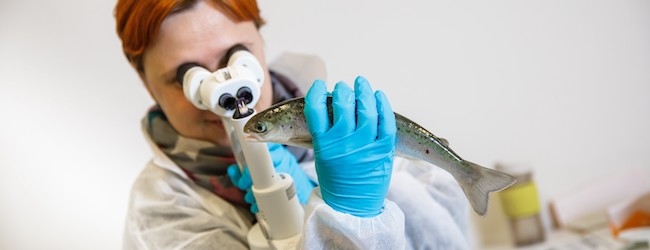
Features
Research
Norwegian study shows smaller salmon smolt grow faster in seawater grow-out
One hundred and 200-gram salmon smolt grew more quickly when put into seawater for grow-out compared to 600-gram fish.
This was part of the results of a study conducted by researchers from the Norwegian Institute of Food, Fisheries and Aquaculture Research (Nofima) which compared performance in terms of growth, survival, health, maturation of salmon produced by using different production protocols in RAS.
“We do not know the reason for the reduced growth during summer in the fish transferred at 600 grams. The trend was the same in all 600 grams-transferred fish, irrespective of photoperiod or salinity in RAS. We are, at the moment, doing analysis of fish composition to see if we can find an explanation,” Nofima scientist Trine Ytrestøyl told Hatchery International.
Cost implications
Ytrestøyl presented the study at the Aquaculture Innovation Workshop (AIW) 2017 in November in Vancouver. “Since the presentation at AIW, we have done the final sampling, and the 600-gram fish grew very well during the final two months in the sea from September to end of November. But despite their catch-up growth, they were still smaller than the 100 and 200 grams- transferred fish at slaughter in late November,” she said.
Cost implications are not covered by the project, she said, because it is very dependent on the sea lice situation. “If this is taken into account, it may be more economical to use the larger post-smolt of 600 grams even if it grows a little slower in the seawater phase,” she said.
The larger fish, she explained, can reduce grow-out time in open sea cage by 2.5 months, which saves one to two delousing operations, compared to stocking with 100- and 200-gram fish.
There are also health benefits, she added, because delousing is tough on the fish and leads both to reduced growth and some mortality.
It is a common procedure these days to produce salmon smolt to a bigger size before they are put in seawater for grow-out.
Seawater tolerant salmon
“Some believe that a larger size makes the fish better able to cope with sweater because they have a smaller surface/volume ratio compared to smaller fish. Thus it should be less energy-demanding for them to regulate their ion levels in seawater. In seawater, water has a higher osmolarity than the fish, so ions will diffuse into the fish, which has to spend energy to get rid of ions to keep its osmotic balance,” she said.
The traditional way produces 70- to 100-gram smolts. There has been an increase in smolt size up to 200 to 500 grams because it cuts production time in open sea cages, a procedure seen as critical in avoiding problems with salmon lice and other diseases.
“We wanted to test if it was possible to produce a seawater-tolerant salmon without using a winter signal with short day for six weeks, and also how larger fish (600 grams) would perform compared to smaller fish (200 grams) at transfer. We used brackish water at 12 ppt in some treatments in RAS to see if this would improve growth and seawater tolerance and performance after seawater transfer,” she said of the study.
Natural way
In nature, Atlantic salmon go through a smoltification process to prepare them for life in seawater and this physiological change is induced by the dark winter.
In aquaculture, however, smoltification has been induced by giving the small salmon juveniles, called parr, a period of short days of six weeks with-12 hour light and 12-hour darkness, followed by a minimum period of four weeks with 24-hour daylight.
“This is sufficient to trigger the transformation from a freshwater adapted parr to a seawater adapted smolt,” she said.
“In RAS, growers want to have optimal growth, and be able to feed the fish 24 hour, so they would like to produce a fish that can go to seawater without having a period with 12:12 light/darkness; the salmon is not fed in darkness.”
March 6, 2018 By Ruby Gonzalez
 All sampled fish were examined for external welfare parameters; Researcher Jelena Kolarevic at Nofima is evaluating cataract
All sampled fish were examined for external welfare parameters; Researcher Jelena Kolarevic at Nofima is evaluating cataract Print this page





